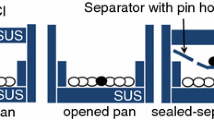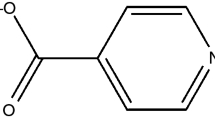Abstract
The products evolved during the thermal decomposition of kaolinite–urea intercalation complex were studied by using TG–FTIR–MS technique. The main gases and volatile products released during the thermal decomposition of kaolinite–urea intercalation complex are ammonia (NH3), water (H2O), cyanic acid (HNCO), carbon dioxide (CO2), nitric acid (HNO3), and biuret ((H2NCO)2NH). The results showed that the evolved products obtained were mainly divided into two processes: (1) the main evolved products CO2, H2O, NH3, HNCO are mainly released at the temperature between 200 and 450 °C with a maximum at 355 °C; (2) up to 600 °C, the main evolved products are H2O and CO2 with a maximum at 575 °C. It is concluded that the thermal decomposition of the kaolinite–urea intercalation complex includes two stages: (a) thermal decomposition of urea in the intercalation complex takes place in four steps up to 450 °C; (b) the dehydroxylation of kaolinite and thermal decomposition of residual urea occurs between 500 and 600 °C with a maximum at 575 °C. The mass spectrometric analysis results are in good agreement with the infrared spectroscopic analysis of the evolved gases. These results give the evidence on the thermal decomposition products and make all explanation have the sufficient evidence. Therefore, TG–MS–IR is a powerful tool for the investigation of gas evolution from the thermal decomposition of materials and its intercalation complexes.






Similar content being viewed by others
References
Komori Y, Sugahara Y, Kuroda K. Direct intercalation of poly(vinylpyrrolidone) into kaolinite by a refined guest displacement method. Chem Mater. 1998;11(1):3–6.
Pavlidou S, Papaspyrides CD. A review on polymer-layered silicate nanocomposites. Prog Polym Sci. 2008;33(12):1119–98.
Liu P. Polymer modified clay minerals: a review. Appl Clay Sci. 2007;38(1–2):64–76.
Letaief S, Aranda P, Fernandez-Saavedra R, Margeson JC, Detellier C, Ruiz-Hitzky E. Poly(3,4-ethylenedioxythiophene)-clay nanocomposites. J Mater Chem. 2008;18(19):2227–33.
Gardolinski JE, Ramos LP, de Souza GP, Wypych F. Intercalation of benzamide into kaolinite. J Colloid Interface Sci. 2000;221(2):284–90.
Frost RL, Horváth E, Makó É, Kristóf J, Cseh T. The effect of mechanochemical activation upon the intercalation of a high-defect kaolinite with formamide. J Colloid Interface Sci. 2003;265(2):386–95.
Frost RL, Horváth E, Makó É, Kristóf J. Modification of low- and high-defect kaolinite surfaces: implications for kaolinite mineral processing. J Colloid Interface Sci. 2004;270(2):337–46.
Gardolinski JEFC, Lagaly G. Grafted organic derivatives of kaolinite: II. Intercalation of primary n-alkylamines and delamination. Clay Miner. 2005;40(4):547–56.
Jia X, Li Y, Zhang B, Cheng Q, Zhang S. Preparation of poly(vinyl alcohol)/kaolinite nanocomposites via in situ polymerization. Mater Res Bull. 2008;43(3):611–7.
Kaljuvee T, Keelman M, Trikkel A, Petkova V. TG–FTIR/MS analysis of thermal and kinetic characteristics of some coal samples. J Therm Anal Calorim. 2013;113:1063-71.
Mothé M, Mothé C, de Carvalho C, Oliveira M. Thermal investigation of heavy crude oil by simultaneous TG–DSC–FTIR and EDXRF. J Therm Anal Calorim. 2013;113(2):525–31.
Ahamad T, Alshehri S. Thermal degradation and evolved gas analysis of thiourea-formaldehyde resin (TFR) during pyrolysis and combustion. J Therm Anal Calorim. 2012;109(2):1039–47.
Takenawa R, Komori Y, Hayashi S, Kawamata J, Kuroda K. Intercalation of nitroanilines into kaolinite and second harmonic generation. Chem Mater. 2001;13(10):3741–6.
Elmas E, Yildiz K, Toplan N, Özkan Toplan H. The non-isothermal kinetics of mullite formation in mechanically activated kaolinite–alumina ceramic system. J Therm Anal Calorim. 2012;108(3):1201–6.
Churchman GJ, Whitton JS, Claridge GGC, Theng BKG. Intercalation method using formamide for differentiating halloysite from kaolinite. Clays Clay Miner. 1984;32(4):241–8.
Joussein E, Petit S, Delvaux B. Behavior of halloysite clay under formamide treatment. Appl Clay Sci. 2007;35(1–2):17–24.
Costanzo PM, Giese RF. Ordered halloysite: dimethylsulfoxide intercalate. Clays Clay Miner. 1986;34(1):105–7.
Nicolini KP, Fukamachi CRB, Wypych F, Mangrich AS. Dehydrated halloysite intercalated mechanochemically with urea: thermal behavior and structural aspects. J Colloid Interface Sci. 2009;338(2):474–9.
Frost RL, Kristof J, Horvath E, Kloprogge JT. Rehydration and phase changes of potassium acetate-intercalated halloysite at 298 K. J Colloid Interface Sci. 2000;226(2):318–27.
Luca V, Thomson S. Intercalation and polymerisation of aniline within a tubular aluminosilicate. J Mater Chem. 2000;10:2121–6.
Horváth E, Kristóf J, Frost R, Rédey Á, Vágvölgyi V, Cseh T. Hydrazine-hydrate intercalated halloysite under controlled-rate thermal analysis conditions. J Therm Anal Calorim. 2003;71(3):707–14.
Franco F, Pérez-Maqueda LA, Pérez-Rodríguez JL. The influence of ultrasound on the thermal behaviour of a well ordered kaolinite. Thermochim Acta. 2003;404(1–2):71–9.
Franco F, Pérez-Maqueda LA, Pérez-Rodríguez JL. The effect of ultrasound on the particle size and structural disorder of a well-ordered kaolinite. J Colloid Interface Sci. 2004;274(1):107–17.
Franco F, Cecila JA, Pérez-Maqueda LA, Pérez-Rodríguez JL, Gomes CSF. Particle-size reduction of dickite by ultrasound treatments: effect on the structure, shape and particle-size distribution. Appl Clay Sci. 2007;35(1–2):119–27.
Cheng H, Liu Q, Zhang J, Yang J, Frost RL. Delamination of kaolinite–potassium acetate intercalates by ball-milling. J Colloid Interface Sci. 2010;348(2):355–9.
Cheng H, Liu Q, Yang J, Du X, Frost RL. Influencing factors on kaolinite–potassium acetate intercalation complexes. Appl Clay Sci. 2010;50(4):476–80.
Cheng H, Liu Q, Yang J, Ma S, Frost RL. The thermal behavior of kaolinite intercalation complexes-A review. Thermochim Acta. 2012;545:1–13.
Cheng H, Liu Q, Yang J, Zhang Q, Frost RL. Thermal behavior and decomposition of kaolinite–potassium acetate intercalation composite. Thermochim Acta. 2010;503–504:16–20.
Cheng H, Liu Q, Yang J, Zhang J, Frost RL. Thermal analysis and infrared emission spectroscopic study of halloysite-potassium acetate intercalation compound. Thermochim Acta. 2010;511(1–2):124–8.
Li Z, Jiang W-T. A thermogravimetric investigation of alkylammonium intercalation into rectorite. Thermochim Acta. 2009;483(1–2):58–65.
Cheng H, Yang J, Liu Q, Zhang J, Frost RL. A spectroscopic comparison of selected Chinese kaolinite, coal bearing kaolinite and halloysite—a mid-infrared and near-infrared study. Spectrochim Acta A Mol Biomol Spectrosc. 2010;77(4):856–61.
Cheng H, Frost RL, Yang J, Liu Q, He J. Infrared and infrared emission spectroscopic study of typical Chinese kaolinite and halloysite. Spectrochim Acta A Mol Biomol Spectrosc. 2010;77(5):1014–20.
Cheng H, Yang J, Frost RL, Wu Z. Infrared transmission and emission spectroscopic study of selected Chinese palygorskites. Spectrochim Acta A Mol Biomol Spectrosc. 2011;83(1):518–24.
Madarász J, Bombicz P, Okuya M, Kaneko S, Pokol G. Comparative online coupled TG–FTIR and TG/DTA–MS analyses of the evolved gases from thiourea complexes of SnCl2: tetrachloropenta(thiourea) ditin(II), a compound rich in thiourea. J Anal Appl Pyrolysis. 2004;72(2):209–14.
Madarász J, Brăileanu A, Crişan M, Pokol G. Comprehensive evolved gas analysis (EGA) of amorphous precursors for S-doped titania by in situ TG–FTIR and TG/DTA–MS in air: part 2. Precursor from thiourea and titanium(IV)-n-butoxide. J Anal Appl Pyrolysis. 2009;85(1–2):549–56.
Madarász J, Varga PP, Pokol G. Evolved gas analyses (TG/DTA–MS and TG–FTIR) on dehydration and pyrolysis of magnesium nitrate hexahydrate in air and nitrogen. J Anal Appl Pyrolysis. 2007;79(1–2):475–8.
Ahamad T, Alshehri SM. TG–FTIR–MS (evolved gas analysis) of bidi tobacco powder during combustion and pyrolysis. J Hazard Mater. 2012;199–200:200–8.
Madarász J, Pokol G. Comparative evolved gas analyses on thermal degradation of thiourea by coupled TG–FTIR and TG/DTA–MS instruments. J Therm Anal Calorim. 2007;88(2):329–36.
Miklós Szilágyi I, Madarász J, Hange F, Pokol G. Online evolved gas analyses (EGA by TG–FTIR and TG/DTA–MS) and solid state (FTIR, XRD) studies on thermal decomposition and partial reduction of ammonium paratungstate tetrahydrate. Solid State Ion. 2004;172(1–4):583–6.
Horváth E, Kristóf J, Kurdi R, Makó É, Khunová V. Study of urea intercalation into halloysite by thermoanalytical and spectroscopic techniques. J Therm Anal Calorim. 2011;105(1):53–9.
Cucos A, Budrugeac P. Simultaneous TG/DTG-DSC-FTIR characterization of collagen in inert and oxidative atmospheres. J Therm Anal Calorim. 2013. doi:10.1007/s10973-013-3116-1.
Cervantes-Uc JM, Espinosa JIM, Cauich-Rodríguez JV, Ávila-Ortega A, Vázquez-Torres H, Marcos-Fernández A, San Román J. TGA/FTIR studies of segmented aliphatic polyurethanes and their nanocomposites prepared with commercial montmorillonites. Polym Degrad Stab. 2009;94(10):1666–77.
Huang N, Wang J. A TGA–FTIR study on the effect of CaCO3 on the thermal degradation of EBA copolymer. J Anal Appl Pyrolysis. 2009;84(2):124–30.
Mehring M, Elsener M, Kröcher O. Development of a TG–FTIR system for investigations with condensable and corrosive gases. J Therm Anal Calorim. 2011;105(2):545–52.
Loría-Bastarrachea M, Herrera-Kao W, Cauich-Rodríguez J, Cervantes-Uc J, Vázquez-Torres H, Ávila-Ortega A. A TG/FTIR study on the thermal degradation of poly(vinyl pyrrolidone). J Therm Anal Calorim. 2011;104(2):737–42.
Beneš M, Milanov N, Matuschek G, Kettrup A, Plaček V, Balek V. Thermal degradation of PVC cable insulation studied by simultaneous TG–FTIR and TG–EGA methods. J Therm Anal Calorim. 2004;78(2):621–30.
Tănase C, Odochian L, Apostolescu N, Pui A. TG–FTIR analysis applied to the study of thermal behaviour of some edible mushrooms. J Therm Anal Calorim. 2011;103(3):1079–85.
Madarász J, Krunks M, Niinistö L, Pokol G. Evolved gas analysis of dichlorobis(thiourea)zinc(II) by coupled TG–FTIR and TG/DTA-MS techniques. J Therm Anal Calorim. 2004;78(2):679–86.
Charland JP, MacPhee JA, Giroux L, Price JT, Khan MA. Application of TG–FTIR to the determination of oxygen content of coals. Fuel Process Technol. 2003;81(3):211–21.
MacPhee JA, Giroux L, Charland JP, Gransden JF, Price JT. Detection of natural oxidation of coking coal by TG–FTIR—mechanistic implications. Fuel. 2004;83(13):1855–60.
Bowley B, Hutchinson EJ, Gu P, Zhang M, Pan W-P, Nguyen C. The determination of the composition of polymeric composites using TG–FTIR. Thermochim Acta. 1992;200:309–15.
Zhu HM, Yan JH, Jiang XG, Lai YE, Cen KF. Study on pyrolysis of typical medical waste materials by using TG–FTIR analysis. J Hazard Mater. 2008;153(1–2):670–6.
Reggers G, Ruysen M, Carleer R, Mullens J. TG–GC–MS, TG–MS and TG–FTIR applications on polymers and waste products. Thermochim Acta. 1997;295(1–2):107–17.
Zhang B, Li Y, Pan X, Jia X, Wang X. Intercalation of acrylic acid and sodium acrylate into kaolinite and their in situ polymerization. J Phys Chem Solids. 2007;68(2):135–42.
Makó É, Kristóf J, Horváth E, Vágvölgyi V. Kaolinite–urea complexes obtained by mechanochemical and aqueous suspension techniques—a comparative study. J Colloid Interface Sci. 2009;330(2):367–73.
Hinckley DN. Variability in “crystallinity” values among the kaolin deposits of the coastal plain of Georgia and South Carolina. Clays Clay Miner. 1963;11:229–35.
Frost RL, Kristof J, Paroz GN, Kloprogge JT. Molecular structure of dimethyl sulfoxide intercalated kaolinites. J Phys Chem B. 1998;102(43):8519–32.
Frost RL, Kristof J, Tran TH. Kinetics of deintercalation of potassium acetate from kaolinite; a Raman spectroscopic study. Clay Miner. 1998;33(4):605–17.
Wiewióra A, Brindley GW. Potassium acetate intercalation in kaolinites and its removal: effect of material characteristics. In: Heller L, editor. Proceedings of the international clay conference Tokyo. Jerusalem: Israel University Press; 1969. p. 723–33.
Schaber PM, Colson J, Higgins S, Thielen D, Anspach B, Brauer J. Thermal decomposition (pyrolysis) of urea in an open reaction vessel. Thermochim Acta. 2004;424(1–2):131–42.
Lundström A, Andersson B, Olsson L. Urea thermolysis studied under flow reactor conditions using DSC and FT-IR. Chem Eng J. 2009;150(2–3):544–50.
Sahnoune F, Saheb N, Khamel B, Takkouk Z. Thermal analysis of dehydroxylation of Algerian kaolinite. J Therm Anal Calorim. 2012;107(3):1067–72.
Pop N, Mogoş AM, Vlase G, Vlase T, Doca N. Theoretic analysis and experimental evidence for relationships between the derivative thermogravimetric curves and the Gramm–Schmidt profiles. J Therm Anal Calorim. 2013;113(1):113–9.
Likozar B, Korošec R, Poljanšek I, Ogorelec P, Bukovec P. Curing kinetics study of melamine–urea–formaldehyde resin. J Therm Anal Calorim. 2012;109(3):1413–22.
Bai ML, Zhao S, Asuha S. Synthesis and thermal decomposition of Cr–urea complex. J Therm Anal Calorim 2013. doi:10.1007/s10973-013-3260-7.
Acknowledgements
The authors gratefully acknowledge the financial support provided by the National Natural Science Foundation of China (Nos. 51034006 and 41002128), China Postdoctoral Science Foundation funded project (Nos. 2011M500034 and 2012T50160) and the Open Research Project of State Key Laboratory for Coal Resources and Safe Mining, China University of Mining & Technology (SKLCRSM11KFB06).
Author information
Authors and Affiliations
Corresponding authors
Rights and permissions
About this article
Cite this article
Cheng, H., Liu, Q., Liu, J. et al. TG–MS–FTIR (evolved gas analysis) of kaolinite–urea intercalation complex. J Therm Anal Calorim 116, 195–203 (2014). https://doi.org/10.1007/s10973-013-3383-x
Received:
Accepted:
Published:
Issue Date:
DOI: https://doi.org/10.1007/s10973-013-3383-x




